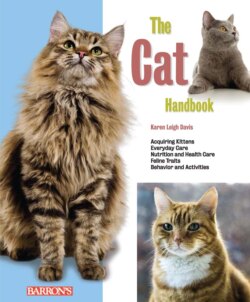Читать книгу The Cat Handbook - Karen Leigh Davis - Страница 13
На сайте Литреса книга снята с продажи.
How the Cat Fancy Began
ОглавлениеBy the late 1800s people had begun to view cats as more than mere mousers. As cat shows and the cat fancy—the collective term used to describe those interested in breeding and showing purebred cats—developed first in England, then spread to America, cats gained popularity as companion animals. People even began importing exotic breeds, such as longhaired and Siamese cats, from abroad. Some of these cats were allowed to run free and mingle with the domestic shorthair stock already flourishing on native soil. As a result, kittens began to appear with varying coat lengths, color patterns, and temperaments, lending even more diversity to the melting pot.
A purebred cat, of course, is bred from members of a recognized breed or its allowable outcrosses and has a recorded ancestry. A non-pedigreed or mixed-breed cat, on the other hand, is generally understood to be the feline equivalent of what canine enthusiasts affectionately refer to as a mutt. While sometimes it may be obvious that one parent was of a specific breed, such as a Siamese, the mixed-breed cat’s ancestry is, in most cases, unknown and unverifiable.
Today, the more politically correct and probably the more accurate term for cats of uncertain ancestry is random bred. Language purists may argue that the term mixed breed more properly means that at least two recognized breeds have been mixed or crossbred—say, a purebred Persian was mated with an American Shorthair, or a Russian Blue was crossed with an Abyssinian to produce offspring. Yet, the more common reference—mixed breed—remains well understood by the general populace to mean a little bit of this and a little dash of that, with who knows what else added for extra flair.
First cat show: With the rise of the cat fancy came the cat shows. Harrison Weir staged the first cat show in 1871 at London’s Crystal Palace. Weir also developed the first breed standards by which cats were judged in those days and served as president of Great Britain’s first national cat club, which issued the first feline stud book in the late 1800s.
The United States was quick to follow Great Britain’s lead, as cat exhibits and judgings have taken place here since the 1870s. But an official all-breed show held in 1895 at New York’s Madison Square Garden marked the real beginning of interest among North American cat fanciers. In 1899 the first and oldest U.S. cat registry, the American Cat Association (ACA), was formed to keep records.
Today, numerous cat-registering associations exist in North America. They include the Cat Fanciers’ Association (CFA), the American Cat Fanciers’ Association (ACFA), the International Cat Association (TICA), the Cat Fanciers’ Federation (CFF), the American Association of Cat Enthusiasts (AACE), the National Cat Fanciers’ Association (NCFA), the United Feline Organization (UFO), the Canadian Cat Association (CCA), and the Traditional Cat Association (TCA). Each association has its own show rules and breed standards, but all maintain stud books, register purebred cats, and verify pedigrees. Most of them also charter clubs, sanction shows, and present awards and titles. CFA, incorporated in 1919, is the world’s largest registry of pedigreed cats, sponsoring approximately 400 shows a year across the United States and internationally through its more than 650 member clubs.
While preference is given to purebred cats in the cat show world, most associations sponsor house-
